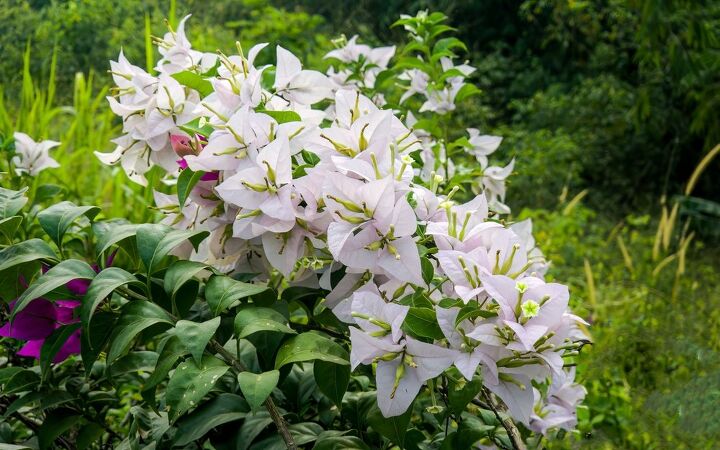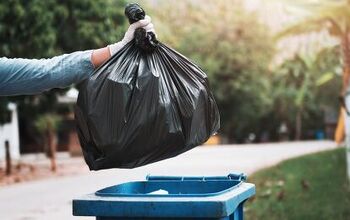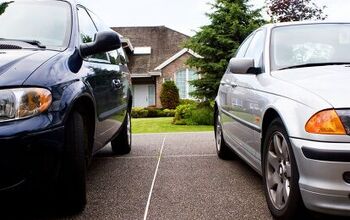What Keeps Eating My Bougainvillea?

Bougainvillea is one of the most beautiful plants, and it looks great in any garden. That said, many pests are attracted to them and love to eat the leaves. So, what keeps eating my bougainvillea?
Bougainvillea loopers are the biggest natural predators of bougainvillea. These small caterpillars, that eventually turn into moths, eat bougainvillea. Other pests, such as slugs, whiteflies, and even rats also love to eat bougainvillea leaves. Luckily, bougainvillea loopers don’t kill bougainvillea in most cases — they simply disfigure the leaves.
Neem oil and several store-bought pesticides can protect your bougainvillea from pests. Follow along as we explore what keeps eating your bougainvillea and highlight tips to protect your plant.
What Bugs Eat Bougainvillea Leaves?
Bougainvillea loopers most commonly eat bougainvillea leaves. These small caterpillars eat bougainvillea and eventually turn into moths. It can be quite frustrating, as several bougainvillea loopers may eat many leaves throughout the vines at once.
You are most likely to find bougainvillea loopers at night on warm days. They stick around for 23-95 days, so loopers can damage the leaves for quite a while. Aphids and leaf miners also eat bougainvillea leaves, but they are easy to distinguish from loopers.
You may also discover spider mites on your bougainvillea, and that is a tough problem to get rid of. Other bugs, such as Oriental scale and Florida scale insects also eat bougainvillea. Discovering which type of bug keeps eating your bougainvillea can help you get rid of them.
How Do I Keep Bugs From Eating My Bougainvillea?
The best ways to keep bugs from eating your bougainvillea are to use neem oil and insecticide sprays. That said, you don’t want to oversaturate the leaves, or you may damage your bougainvillea. Carefully inspect the leaves to find which areas are the most damaged and covered with bugs.
Some pests, like spider mites, are hard to identify unless you get close to the leaves. They look almost like white dots because they’re so small. Even still, you can likely find small holes in the leaves if you have aphids or bougainvillea loopers.
Follow the directions on the insecticide’s label, so you don’t use too much and damage the bougainvillea. Many people dilute neem oil into a gallon of water with a tablespoon of dish soap to kill aphids. This solution shouldn’t damage the plant, but it should keep bugs from eating your bougainvillea.
Slugs
Even slugs like to eat bougainvillea, and they can be tricky to get rid of. Of course, you can manually remove slugs as you see them, but that only helps so much. Instead, you should try to make it hard for slugs to thrive near your bougainvillea.
The best way to do that is to get rid of rocks, leaves, and piles of sticks that slugs hide under. This will make the slugs find another area to hide far away from your bougainvillea. It also helps to manually move slugs as you encounter them.
Whiteflies
Whiteflies also prey upon bougainvillea, and they can be hard to get rid of. Your best bet is to put sticky traps near your bougainvillea. Granted, this is mostly only a good option if you keep your bougainvillea indoors.
It’s considered inhumane to put sticky traps outside because you can unintentionally harm wildlife. For example, squirrels, beneficial insects, rodents, and birds can get stuck in traps. The best way to get rid of whiteflies outside is to trim the leaves on your bougainvillea.
They will be less likely to flock to your bougainvillea, and this can also deter other pests. Avoid fertilizer that contains too much nitrogen, as that can attract whiteflies.
What Is The Best Insecticide For Bougainvillea?
The best insecticide for bougainvillea is bacillus thuringiensis. This is the best option if you find bougainvillea loopers. The main benefit of bacillus thuringiensis is that it only targets bougainvillea loopers.
It won’t harm the many helpful insects that aid in the growth of bougainvillea. That includes everything from ladybugs and green lacewings to lady beetles. Those bugs naturally prey upon aphids who would otherwise damage your bougainvillea.
Use something like Demon Max Insecticide if many pests eat your bougainvillea. Granted, that will kill many bugs besides aphids, but it will protect your bougainvillea.
Are Bougainvillea Loopers Bad For Gardens?
While bougainvillea loopers damage leaves, they aren’t typically bad for gardens. That said, the cosmetic damage that bougainvillea loopers cause can be quite annoying. The small holes and spots on the leaves that loopers cause can throw off the plant’s appearance.
You must be careful and monitor the situation if the bougainvillea loopers eat too much of the leaves. They can eventually remove the leaves altogether, also known as defoliation. That only happens in extreme cases when there are many bougainvillea loopers around.
Defoliation is more likely if you do nothing to get rid of the pests that eat the leaves. That’s why you should check on your bougainvillea every day and keep an eye out for holes in the leaves.
Do Bougainvillea Attract Rats?
Bougainvillea can attract rats, especially when the plant is thick and low to the ground. The thick foliage attracts rats and other pests. Rats like to nest in bougainvillea because of the thick foliage and cover it provides.
Unfortunately, rats also eat bougainvillea in some cases, and that’s harder to stop than getting rid of aphids. That is particularly common with young bougainvillea plants, as the leaves are soft and appetizing. However, bougainvillea leaves eventually become harder as the plant grows, so rats are less likely to eat it.
Trim your bougainvillea often,so that it doesn’t become overgrown, or else it may attract rats. The bushier your bougainvillea is, the more likely rats are to flock to it. Pack rats particularly love bougainvillea in desert climates.
Where Should You Plant Bougainvillea?
Ideally, you should plant bougainvillea in high-ground areas. Low spots are more likely to attract rodents and other pests, such as bougainvillea loopers and aphids. Bougainvillea plants are also unlikely to thrive in low spots that can easily become waterlogged.
That said, you may want to keep bougainvillea in pots and containers if you live in a climate with cold winters. Bougainvillea isn’t cold hardy, and it can die if the temperature falls to 32-34 degrees Fahrenheit. Because of that, it won’t survive the winter unless you bring your bougainvillea inside.
It’s also much easier to fight pests if you keep your bougainvillea in a container. That way, you can separate it from other plants and treat your bougainvillea for pests if you find them.
Summing It Up
Bougainvillea loopers, slugs, whiteflies, and aphids often eat bougainvillea. Prune your bougainvillea often to keep pests away, and make sure to treat the leaves with diluted neem oil. Grow your bougainvillea in a pot and move it inside for winter to reduce the risk of pests.
Related Guides:

Nick Durante is a professional writer with a primary focus on home improvement. When he is not writing about home improvement or taking on projects around the house, he likes to read and create art. He is always looking towards the newest trends in home improvement.
More by Nick Durante



























